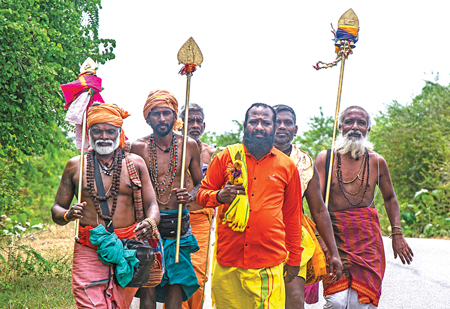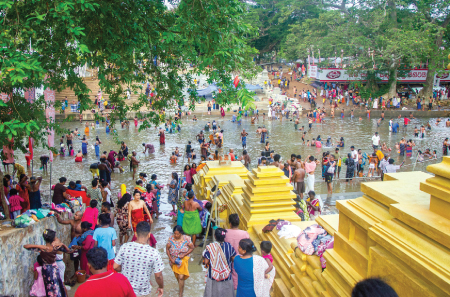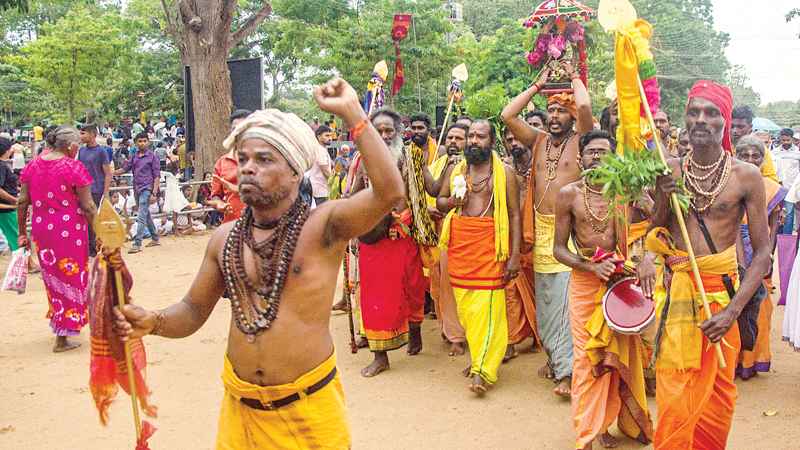 Earnest devotees of Kataragama by the thousands—hailing from all communities, not least Tamil Hindus—are undertook the annual Pada Yatra or foot pilgrimage through the Kumana and Yala National Parks to Kataragama for the annual Esala festival that concluded on Thursday.
Earnest devotees of Kataragama by the thousands—hailing from all communities, not least Tamil Hindus—are undertook the annual Pada Yatra or foot pilgrimage through the Kumana and Yala National Parks to Kataragama for the annual Esala festival that concluded on Thursday.
In July 2024, I set off for a long-awaited adventure to document the Pada Yatra, the most famous traditional Hindu pilgrimage in Sri Lanka, and also one of the largest confluences of humanity in the island. The Pada Yatra is a testament to the human quest for divinity and spiritual liberation. We drove down to Kataragama, and after arriving in the morning, we went to straight to the Ganadevi Temple at Katagamuwa to see the Pada Yatra pilgrims who gathered there as their final stop in their long trek. At Katagamuwa, I spoke to some of the swamis and pilgrims of Pada Yatra and photographed a series of portraits of swamis and pilgrims.
Among Sri Lanka’s living traditions, few are as well-known or as poorly understood as the Kataragama Pada Yatra or foot pilgrimage. Starting from the island’s far North and arriving nearly two months later at the Kataragama shrine in the island’s remote Southeastern jungle, the Pada Yatra has played a major role in propagating and perpetuating Kataragama’s spiritual tradition throughout Sri Lanka and South India.
The oldest tradition

‘Vel’ carrying swamis at Katagamuwa on their final leg to Kataragama
Predating the arrival of all four of Sri Lanka’s major religions, the tradition began with the island’s indigenous forest-dwellers, the Wanniya-laeto or ‘Veddas’, as the Kataragama shrine’s priest-custodians themselves readily admit.
The traditional foot pilgrimage or Pada Yatra is not a peace or protest march, but a ritual tradition from hoary antiquity that re-enacts legendary episodes. Its participants are ordinary folks, who say, they are answering a ‘call’.
Because of the sheer length of the Kataragama Pada Yatra, since ancient times, the pilgrims tended to be dedicated religious specialists. The great majority of Pada Yatra swamis remain anonymous, but among them have been more than a few great saints and around them, sagas.
Nearly two months before the great Esala festival in Kataragama, pilgrims gather at sacred sites such as Nagadeepa, Nallur or Selva Sannithi in the far North. Then with a loud chorus of Haro Hara, they proceed as onlookers pause to cheer. Generally, a ‘swami’ among them bears with dignity the God’s ‘Vel’ or lance emblem.
For many pilgrims, the Pada Yatra is a chance to visit ancient shrines all the way to Kataragama in the company of veteran devotees. Their long trek takes them to famous temples at Sittandy, Mamamgam, Kaluthavalai and Mandur in the Batticaloa District. In the Ampara District, they follow the coast via Tirukkovil, Pottuvil and Okanda through the Kumana and Yala National Parks to reach Kataragama.
Leaving everything behind but a bundle of essentials, they experience the homeless life of a beggar or religious recluse. Profound lessons about the paradoxes of life are driven into them in a sustained act of self-denial.
Sleeping and living outside, under trees and in shrines and temples; seldom knowing from where their next meal will come; braving death from animal attacks or disease; these are the elements that make Pada Yatra an unforgettable experience.
Pilgrims represent the full spectrum of society; poets, singers, musicians, dancers and other pilgrims are spread like a leaven through the concourse, as it moves in groups, often appearing to walk alone, along the island’s ever-changing and awe-inspiring landscapes. At night, there is the glow of campfires, shared food, continuous chants of praise from the pilgrim groups and, of course, the wisdom teachings being recited by the elders.
Walking 20 or 30 kilometres per day, the pilgrims halt at 73 traditional places of worship, where they accept dana from waiting villagers. The route carries them down the East coast as far as Pottuvil, where it turns inland to cross the 120 kilometres of jungle to reach Kataragama.
Intrepid pilgrims

Pada Yatra pilgrims bathe in the Menik Ganga at Kataragama
The final stretch of the Yatra takes the intrepid pilgrims through uninhabited jungle of the Kumana and Yala sanctuaries teeming with elephants, deer, sambur and boars. Typically, the jungle claims the life of one or more pilgrims who succumb to fever, wild animals or simply get lost. Those who have passed through, however, bring home stories and memories of nights by the campfire under an open sky that will last a lifetime.
Nowadays, the great majority of foot pilgrims walk from the Batticaloa and Ampara districts, which are much closer to Kataragama than Trincomalee, Vavuniya or Jaffna districts, where only the most fervent devotees are prepared to walk for 40 days or more. Significantly, the Kataragama Pada Yatra attracts a few foreign pilgrims each year as well as Buddhist devotees, despite the hazards and hardship.
The Kataragama Pada Yatra tradition has been making a slow comeback after facing near-extinction amid the North-East civil disturbances during the troubled decades. With the peace and normality prevailing in the country, the pilgrims began to join by the hundreds in the mid-2000’s. They set out on the annual pilgrimage or coastal pilgrimage to God Skanda’s great shrine. They are accompanied by a host of colourful saffron clad swamis and swami ammas, as well as young people and even whole families.
Nowadays, in countries such as India, religious processions and pilgrimages are sources of communal friction. But the Kataragama Pada Yatra remains a source of consensus and communal harmony, a fact that Sri Lankans may rightly reflect upon and be grateful for.







